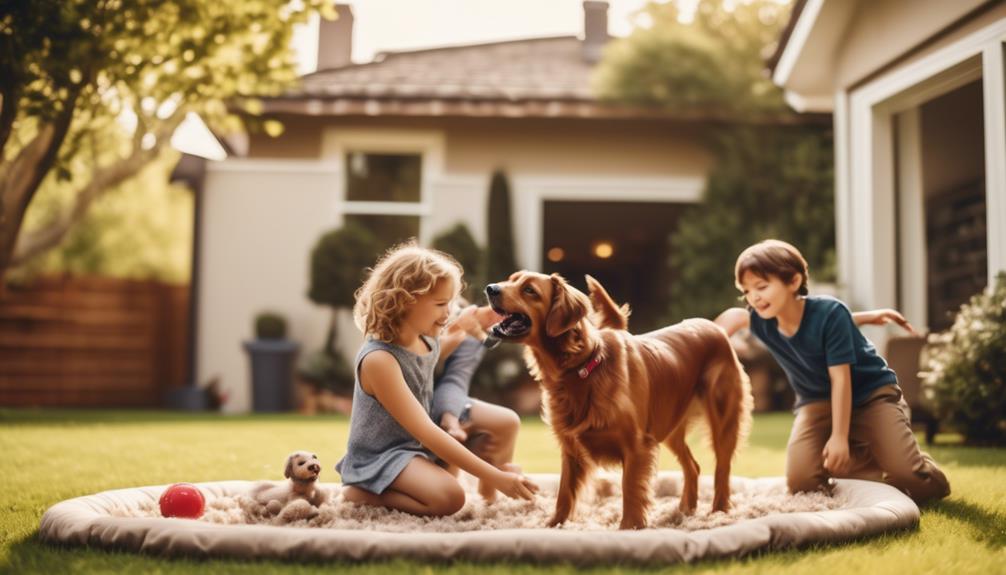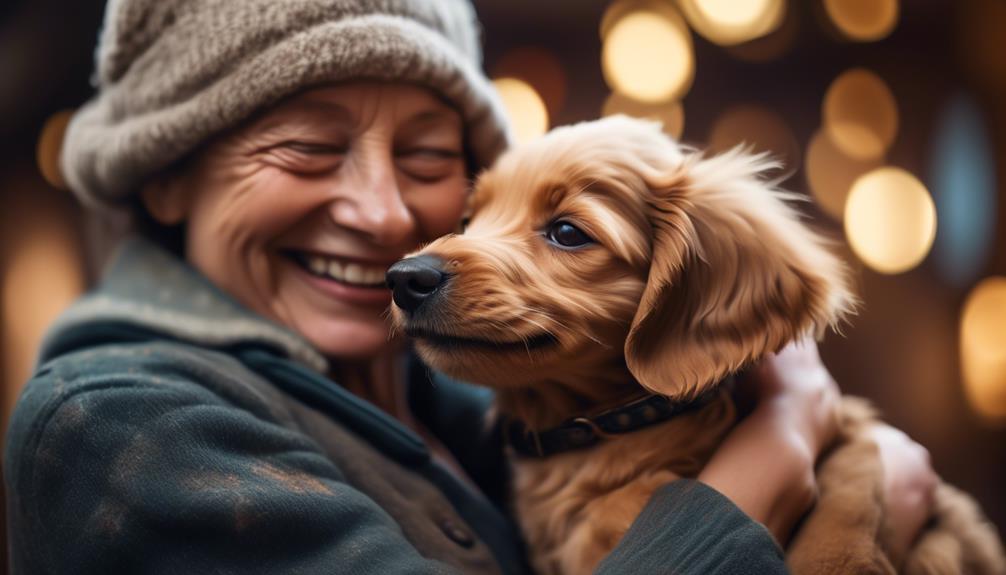Are you ready to embark on a journey of discovery and learn all about the fascinating Dachsador mixed dog breed? These unique canine companions possess a winning combination of traits from the Labrador Retriever and Dachshund.
From their endearing coat colors and physical characteristics to their adaptability and friendliness, there is so much to uncover. But that's not all – we'll also delve into their health considerations, discuss their suitability for apartment living, and explore the factors to consider when choosing a Dachsador.
Get ready to be captivated by these charming mixed breeds and all the facts that make them truly special.
Key Takeaways
- Dachsadors are a mixed breed dog, not a purebred, with common colors including chocolate brown, black, and yellow.
- They are described as small dogs, but their size may vary, with an average weight of 30 to 40 pounds and height ranging from 15 to 25 inches.
- Dachsadors are great family dogs, providing excellent companionship and bonding well with adults and small children.
- They are lively, energetic dogs that love outdoor activities and require mental stimulation through interactive toys. Regular veterinary checkups are important, as they may be predisposed to health conditions of Labrador Retrievers and Dachshunds, such as hip dysplasia, back problems, and eye conditions.
Dachsador Mixed Breed Dog Pictures
Here are some pictures showcasing the adorable appearance and unique characteristics of Dachsador mixed breed dogs. These pictures display the different coat colors and patterns of Dachsadors, as well as their physical features, such as their long bodies and short legs. You can also see them engaging in various activities, like playing, walking, and cuddling.
The pictures of Dachsador puppies are especially cute, highlighting their adorable appearance. As a mixed breed dog, Dachsadors come in common colors such as chocolate brown, black, and yellow. They're described as small dogs, with sizes that may vary. They usually weigh between 30 to 40 pounds and stand at a height of 15 to 25 inches.
Dachsadors make great family dogs, providing excellent companionship. They're friendly and bond well with both adults and small children. However, it's important to note that they can be stubborn, so consider this when socializing and training them.
Dachsadors are lively and energetic, loving outdoor activities. They're also smart, so providing them with interactive toys for mental stimulation is recommended. While they're generally considered healthy, they may be predisposed to health conditions of Labrador Retrievers and Dachshunds.
Regular veterinary checkups are important to ensure their well-being, as they may be prone to health problems such as hip dysplasia, back problems, and eye conditions.
Characteristics of Dachsador Dogs

Dachsador dogs possess a unique combination of characteristics that make them an energetic and friendly breed. They are known for their high energy levels and require at least two walks a day to keep them active and engaged. Dachsadors are also friendly and playful, making them a great fit for families with children. In terms of grooming, they require regular brushing sessions lasting about 10 minutes. To give you a clearer picture of their characteristics, here is a table showcasing some key traits of Dachsador dogs:
| Characteristics | Description |
|---|---|
| Energy Level | High |
| Size | Small to medium |
| Temperament | Friendly and playful |
| Exercise Needs | At least two walks a day |
| Grooming | Regular brushing sessions, 10 minutes |
With their energetic nature and friendly disposition, Dachsadors make wonderful companions for active families looking for a lively and affectionate pet.
Health Considerations for Dachsador Dogs

When considering the health of your Dachsador dog, it's important to be aware of potential health conditions that they may be predisposed to.
While Dachsadors are generally considered healthy dogs, they can be prone to certain health problems that are common in Labrador Retrievers and Dachshunds. One common health issue is hip dysplasia, which is a condition where the hip joint doesn't develop properly and can lead to pain and mobility issues.
Additionally, Dachsadors may also be at risk for back problems, such as intervertebral disc disease, due to their long bodies and short legs. Eye conditions, such as cataracts and progressive retinal atrophy, are also conditions that Dachsadors may be susceptible to.
Regular veterinary checkups and proper care are crucial to ensuring the overall health and well-being of your Dachsador.
Dachsadors and Apartment Living
If you're looking for a dog that can thrive in an apartment setting, the Dachsador is a breed worth considering. While they may have a larger size, they can adapt well to apartment living with the right amount of exercise and mental stimulation. Take a look at the table below for a quick overview of the Dachsador's adaptability to apartment living:
| Adaptability Factors | Yes | No |
|---|---|---|
| Size | ✔️ | |
| Energy Level | ✔️ | |
| Quietness | ✔️ | |
| Polite Behavior | ✔️ |
As you can see, the Dachsador's size alone should not be the sole determinant when choosing a dog for an apartment. While they may be larger, their adaptability factors such as low energy levels, quietness, and polite behavior make them suitable for apartment living. However, it's important to prioritize your neighbors' comfort and ensure that you provide them with regular exercise and mental stimulation to keep them happy and content in your apartment.
Factors to Consider When Choosing a Dachsador

When considering a Dachsador as your potential pet, it's important to carefully evaluate certain factors.
Firstly, you should consider your living situation. Dachsadors can adapt well to apartment living, but size alone shouldn't be the sole determinant. Some larger breeds may be suited to apartment living, while others may require more space and have higher energy levels. Prioritizing qualities such as being quiet, low-energy, and displaying polite behavior towards neighbors is important.
Additionally, you should assess your own experience as a dog owner. Dogs that are good for experienced owners may require more training and experience to handle.
Lastly, it's crucial to consider the energy level of the Dachsador and whether you can provide the necessary exercise and mental stimulation they require.
Dachsador's Friendliness and Adoption

As you continue to explore the Dachsador breed, it's important to understand their friendliness and the adoption process. Here are three key points to consider:
- Dachsadors are known for their friendly and playful nature, making them a great fit for families with children. Their affectionate demeanor will bring joy and companionship to your home.
- Many Dachsadors end up in shelters, so consider adopting from rescue groups. By giving a Dachsador a loving home, you provide them with a second chance at happiness.
- The adoption process typically involves filling out an application, meeting the dog, and paying an adoption fee. This fee helps cover the cost of care and veterinary services provided by the shelter or rescue group.
Frequently Asked Questions
Can Dachsadors Be Trained to Do Tricks or Perform in Dog Shows?
Yes, dachsadors can be trained to do tricks and perform in dog shows. With the right training and socialization, these intelligent and energetic dogs can learn a variety of tricks and excel in performance events.
Are Dachsadors Good With Other Pets, Such as Cats or Small Rodents?
Dachsadors can be good with other pets, such as cats or small rodents, but it depends on their individual temperament and socialization. Proper introduction and supervision are key to ensure a harmonious coexistence.
How Much Exercise Do Dachsadors Require on a Daily Basis?
Dachsadors require at least two walks a day to meet their high energy levels. Regular exercise is important to keep them happy and healthy. Don't forget to play and engage them in activities to keep them mentally stimulated.
Are Dachsadors Prone to Excessive Barking or Howling?
Dachsadors can be prone to excessive barking or howling, depending on individual temperament and training. It's important to provide proper socialization and training to prevent or manage this behavior.
How Well Do Dachsadors Adapt to Different Climates, Such as Hot or Cold Weather?
Dachsadors adapt well to different climates, including hot and cold weather. They have a versatile coat that helps regulate their body temperature. However, it's important to provide appropriate shelter and care in extreme conditions.
What are the common characteristics and facts of mixed dog breeds?
One notable characteristic of a chow shepherd mixed breed is its unpredictable appearance and temperament. These dogs often exhibit a combination of traits from both parent breeds, including a distinctive double coat and a loyal, protective nature. Due to their diverse genetic makeup, they may have varying exercise and grooming needs.
Conclusion
In conclusion, the Dachsador is a wonderful mixed breed dog that brings together the best traits of the Labrador Retriever and Dachshund. With their unique coat colors and physical characteristics, they're undeniably adorable.
They make great family pets, but proper socialization and training are important due to their stubborn nature.
Interestingly, as a designer breed, many Dachsadors end up in shelters, making adoption a fantastic option. Consider adding a Dachsador to your family and enjoy the love and companionship they bring.




